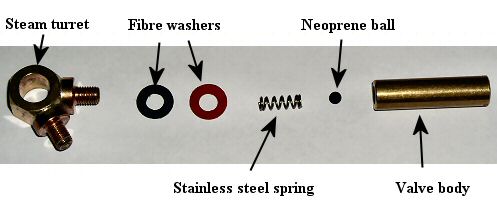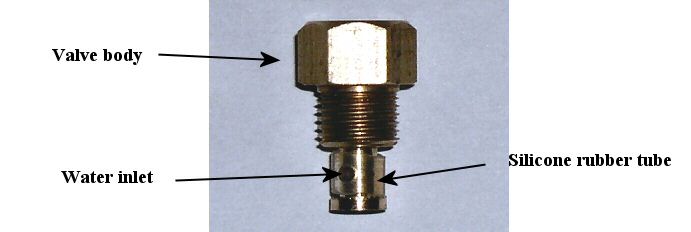
Steam turret mounted water top up valve.
Roundhouse locomotives use two different types of water top up valve as follows.
These use a steam turret mounted valve which comprises a small neoprene ball held lightly against the internal valve seat by a stainless steel spring.

Steam turret mounted water top up valve.
The valve body has a female thread in one end, that screws onto a steam take off on the main steam turret on top of the boiler and is sealed by fibre washers. Inside there is a small neoprene rubber ball and a stainless steel spring. The outside end of the valve body has a tapered, 4mm nominal diameter socket, into which the end of the plastic tube on the water pump bottle, is pushed. As the pump handle is operated, water acts against the neoprene ball and spring, pushing it off it's seat, and allowing water to enter the boiler. When the pump handle is released, spring and boiler pressure push the neoprene ball back against it's seat, closing the valve.
Over time, small particles of dirt and lime scale can build up on and around the ball and seat, preventing it from sealing correctly. This will show up as continuous leaking of the valve. Sometime, this can be cleared by quickly pumping extra water through the valve to flush it out. If however, this does not cure the problem, the valve should be removed and cleaned or parts replaced.
The valve body has a screwdriver slot across the outer end to allow it to be unscrewed from the turret. Note that a thread sealer is used at the factory so it may be a little stiff when first removing.
The parts can be cleaned in kettle de-scaler to remove lime scale and the ball should be carefully checked for any damage - if in doubt, replace.
Assemble in the order shown in the diagram.
As the valve sits horizontally, the spring is used to hold the ball lightly in place until boiler pressure rises. If the spring pressure is too great, the small hand operated water pump on the pump bottle provided, will have difficulty overcoming the pressure, making boiler filling very difficult. If however the spring pressure is too low or the spring does not contact the ball, the valve will leak, particularly at low boiler pressures. To adjust the spring pressure, fibre washers of differing thickness are supplied. Fit one or two as required and extra adjustment can be achieved by thinning a washer on a flat file.
During 2011, a change was made to a much lighter but longer stainless steel spring. This does away with the necessity to adjust spring pressure using different thickness fibre washers. The later spring is a direct replacement for the earlier, stronger spring.
These use a vertically mounted valve which screws either directly into the boiler or into the boiler filler plug.

Vertically mounted water top up valve.
This is a much simpler valve, comprising a brass valve body with a water passage that passes down and then out through the side. A band of silicone rubber is fitted over the water intlet and acts as a non-return valve.
The top face of the valve body has a tapered, 4mm nominal diameter socket, into which the end of the plastic tube on the water pump bottle, is pushed. As the pump handle is operated, water acts against the silicone rubber tube, pushing it off it's seat, and allowing water to enter the boiler. When the pump handle is released, the elasticity of the silicone and boiler pressure, push the silicone tube back against it's seat, closing the valve.
Over time, small particles of dirt and lime scale can build up on the seat under the silicone tube, preventing it from sealing correctly. This will show up as continuous leaking of the valve. Sometime, this can be cleared by quickly pumping extra water through the valve to flush it out. If however, this does not cure the problem, the valve should be removed and cleaned or parts replaced. The valve body has a 10mm AF hexagon on the top to aid removal.
The silicone rubber tube is removed by carefully slipping it over the small flange on the bottom of the valve. The parts can be cleaned in kettle de-scaler to remove lime scale and the tube should be carefully checked for any damage - if in doubt, replace.
A new copper or fibre washer should be used under the head of the valve when re-fitting to the boiler of filler plug.
Roundhouse Engineering Co. Ltd., Doncaster, UK. 2018. Click Here To Return To The Homepage